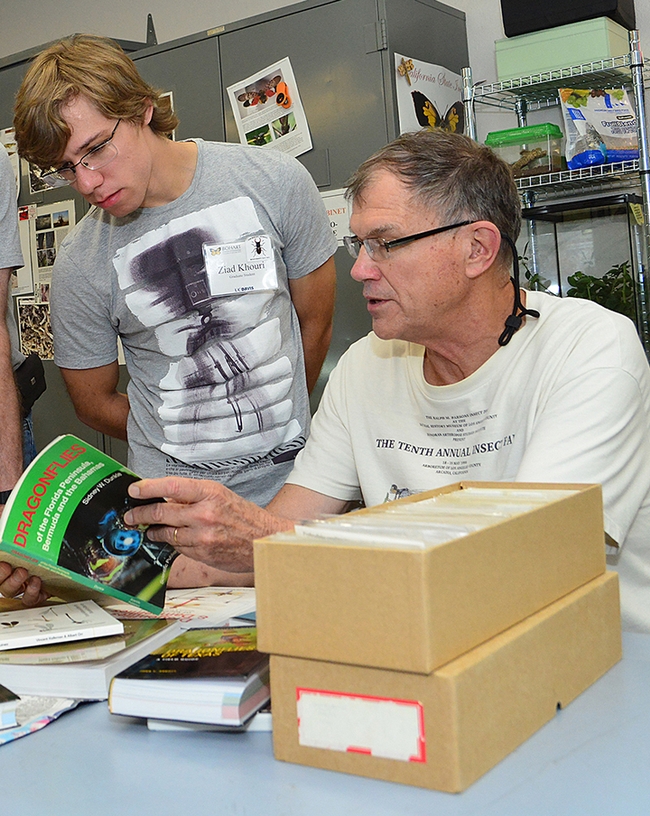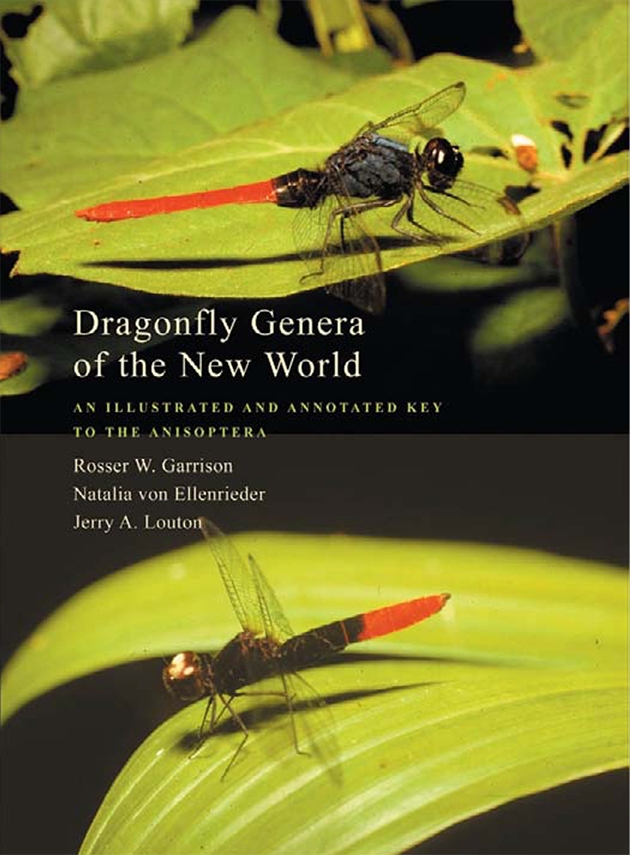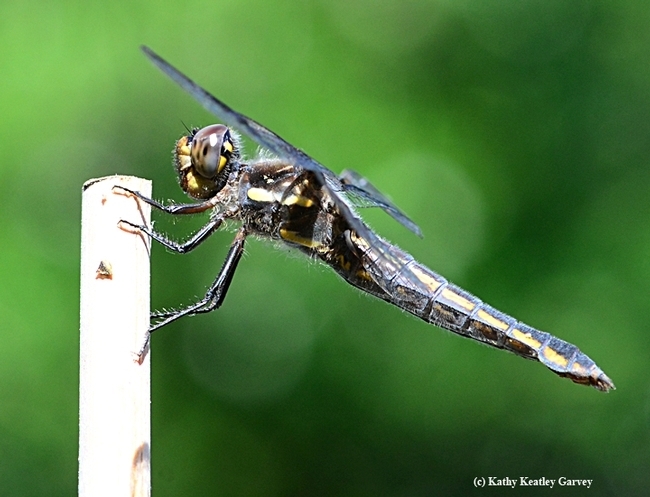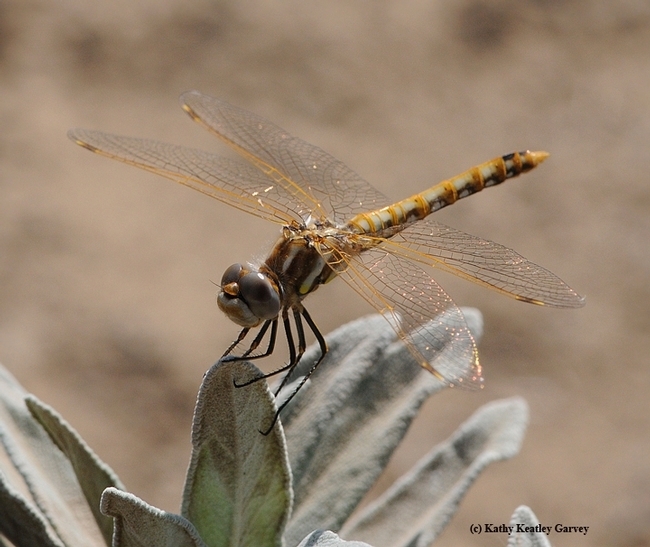- Author: Kathy Keatley Garvey

The event, free and family friendly, takes place in Room 1124 of the Academic Surge Building. 455Crocker Lane, and will feature noted dragonfly expert Rosser Garrison of Sacramento, widely recognized as one of the current leading experts of the taxonomy of New World Odonata.
Garrison, who retired in 2017 as a senior insect biosystematist in the California Department of Food and Agriculture's Plant Pest Diagnostics Branch, Sacramento, continues his research on dragonflies. He has collected more than 50,000 dragonflies specimens throughout the world. His collection now contains more than half of all the known species of the world.
“Dragonfly relatives existed before the onset of the dinosaurs---Triassic Period, 250 to 200 million years ago,” Garrison says. Some of these gigantic dragonfly-like insects had wingspans of about three feet.
Garrison offers other interesting facts about dragonflies:
- They have a primitive flight mechanism compared to other insects, bees, butterflies, beetles and flies.”
- They, at least many dragonflies, mostly mate on the wing.
- They are not poisonous and they do not sew up people's ears (“devil's darning needles”). However, one group of large dragonflies are called—appropriately—"Darners."
- Larvae have a neat prehensile foldable lower lip unique in insects; it is used for capturing prey like mosquito larvae or even small fish.
Garrison received his bachelor of science degree at Northern Arizona University, Flagstaff, Ariz., in 1971, and both his master's degree (1974) and doctorate (1979) from UC Berkeley. From February 1981 to June 1982, he worked as a terrestrial invertebrate ecologist for the Center of Energy and Environment Research where he conducted ecological research in a tropical rain forest at the El Verde Field Station in Luquillo Forest, Puerto Rico.

He developed an interest in insects at age 3. Soon dragonflies and (later) damselflies captivated his interest "due to their overall beauty and fascinating biology."
"I continued to collect and maintain a collection of insects from an early age and later enjoyed identifying them using the third edition of the classic entomology text An Introduction to the Study of Insects by D.J. Borror and D. Delong," he said. His main interest is the systematics of Odonata with a strong emphasis on the Neotropical fauna.
He and his wife, Natalia von Ellenrieder, a senior insect biosystematist with CDFA, have worked intensively with the Odonata fauna of the Neotropical region. He has written more than 100 publications pertaining to Odonata, including three books: Dragonfly Genera of the New World: An Illustrated and Annotated Key to the Anisoptera (2006), Damselfly Genera of the New World: An Illustrated and Annotated Key to the Zygoptera (2010) and, as co-author, Dragonflies of the Yuangas: A Field Guide to the Species from Argentina (2007).
Garrison has written or co-written taxonomic revisions of more than 20 genera of New World Odonata, such as Enallagma (1984), Hetaerina (1990), Erpetogomphus (1994), Mnesarete (2006) and Telebasis (2009). His present taxonomic work, jointly with von Ellenrieder, focuses on the speciose genus Argia on which he has published several revisions (1994, 1996, 2019, 2019, 2007, 2015, 2017, 2018 and 2022 (in press).
Garrison's publications include descriptions of more than 75 new species and six new genera of Odonata. In the Americas, he has done entomological field work in the United States, Mexico, Costa Rica, Panama, Guyana, French Guiana, Venezuela, Ecuador, Peru, Brazil, Argentina and Chile. He has also collected dragonflies in Australia, Papua New Guinea, China, Thailand, Namibia and Iran. One genus and 10 species of Odonates are named after him.
Bohart associate Greg Kareofelas said that other local dragonfly specialists and students "will be there to answer all manner of questions concerning dragonflies and damselflies. Bring photos you have taken to have identifications made." An arts and crafts activity for all ages is also planned.
Throughout the afternoon, the Lepidoptera (butterflies and moths), curated by entomologist Jeff Smith, will be open, as will the live insect display showcasing Madagascar hissing cockroaches, stick insects and tarantulas. Visitors are invited to touch or "pet" the cockroaches and stick insects and take selfies.
The Bohart Museum, founded in 1946, is directed by Lynn Kimsey, UC Davis distinguished professor of entomology. It is the global home of eight million insect specimens, as well as the live "petting zoo" and an insect-themed gift shop stocked with t-shirts, hoodies, books, posters, jewelry, collecting equipment and more. Named for UC Davis professor and noted entomologist Richard Bohart, it is open to the public from 8 a.m. to noon, and 1 to 5 p.m., Mondays through Thursdays.




- Author: Kathy Keatley Garvey

Did you know that their ancestors existed before dinosaurs did? And that fossil records show that they were the world's largest flying insects, some with wingspans measuring three feet?
Dragonfly/damselfly expert Rosser Garrison of the California Department of Food and Agriculture (CDFA) will share his knowledge of dragonflies and damselflies---and showcase some of his global specimens—at the Bohart Museum of Entomology's open house on Sunday, Sept. 20.
The open house, the museum's first of the 2015-16 academic year, is from 1 to 4 p.m. in Room 1124 of the Academic Surge Building on Crocker Lane, corner of Crocker Lane and LaRue Road, University of California, Davis. Admission and parking are free.
“Dragonfly relatives existed before the onset of the dinosaurs---Triassic Period, 250 to 200 million years ago,” Garrison said. Pointing out that these gigantic dragonfly-like insects had wingspans of about three feet, he said that “there was about 20 percent more oxygen in the atmosphere than there is now and other giant insects occurred during that period.”
Garrison will show some of his “Oh, My” dragonflies and videos. “Dragonflies are such neat creatures,” he said. “They are considered beneficial since both larvae---all aquatic--and adults are predators. But one is called the ‘Bee Butcher' and has a reputation for eating honey bees.”
Some interesting facts he related about dragonflies:
- They have a primitive flight mechanism compared to other insects, bees, butterflies, beetles and flies.”
- They, at least many dragonflies, mostly mate on the wing.
- They are not poisonous and they do not sew up people's ears (“devil's darning needles”). However, one group of large dragonflies are called—appropriately—"Darners."
- Larvae have a neat prehensile foldable lower lip unique in insects; it is used for capturing prey like mosquito larvae or even small fish.
Garrison is a senior insect biosystematist in the CDFA's Plant Pest Diagnostics Branch, Sacramento. He identifies various potential invertebrate pests (such as grasshoppers, true bugs and terrestrial mollusks) entering California and determines if they are threats to agricultural commodities.
Garrison's research has resulted in more than 80 published papers dealing with dragonflies, pest insects and includes monographic works and book chapters on tropical ecology and insect systematics.
Garrison was the senior author of two recently published volumes, “Dragonfly Genera of the ew World. An Illustrated and Annotated Key to the Anisoptera” (2006), and “Damselfly Genera of the New World. An Illustrated and Annotated Key to the Zygoptera” (2010), both published by The Johns Hopkins University Press). He has also contributed chapters on invertebrate ecology for “The Food Web of a Tropical Rain Forest” (Chicago University Press, 1996) and “Manu. The Biodiversity of Southeastern Peru” (National Museum of Natural History, 1996).
He has served as the editor of Odonatologica, the quarterly journal of the Societas Internationalis Odonatologica, since January 1998. He has researched and collected dragonflies throughout much of the world, including Puerto Rico, Argentina and Costa Rica.
Garrison received two degrees from the University of California, Berkeley: his master's degree in 1974 and his doctorate in 1979. His doctoral dissertation was on “Population Dynamics and Systematics of the Damselfly genus Enallagma of the western United States (Odonata: Coenagionidae) 1979, published in 1984.
He joined CDFA in December 2004 after serving as a senior biologist/entomologist for Los Angeles County, where he identified all potentially important agricultural invertebrate pests entering the county, and provided insect identification services and advice on their control.
Following the dragonfly/damsel presentation, five other weekend open houses are scheduled:
Saturday, Dec. 5, 1 to 4 p.m.: “Keep Calm and Insect On.”
Sunday, Jan. 10 from 1 to 4 p.m.: “Parasitoid Palooza II”
Saturday, Feb. 13: Biodiversity Museum Day
Saturday, April 16, 10 a.m. to 3 p.m.: UC Davis Picnic Day
Saturday, July 31, 8 to 11 p.m.: “Celebrate Moths.”
The Bohart Museum, directed by Lynn Kimsey, houses a global collection of nearly eight million specimens, including 469 different species of dragonflies.
It is also the home of the seventh largest insect collection in North America, and the California Insect Survey, a storehouse of the insect biodiversity. Noted entomologist Richard M. Bohart (1913-2007) founded the museum.
Special attractions include a “live” petting zoo, featuring Madagascar hissing cockroaches, walking sticks and tarantulas. Visitors are invited to hold the insects and photograph them.
The museum's gift shop, open year around, includes T-shirts, sweatshirts, books, jewelry, posters, insect-collecting equipment and insect-themed candy.
The Bohart Museum's regular hours are from 9 a.m. to noon and 1 to 5 p.m. Mondays through Thursdays. The museum is closed to the public on Fridays and on major holidays. Admission is free. Parking is free on weekends.
More information on the Bohart Museum is available by contacting (530) 752-0493 or emailing bmuseum@ucdavis.edu. Tabatha Yang (tabyang@ucdavis.edu) is the public education and outreach coordinator.
Related Links:
http://www.cdfa.ca.gov/plant/PPD/staff/rgarrison.html/
http://www.cdfa.ca.gov/plant/PPD/entomology/odonata.html



